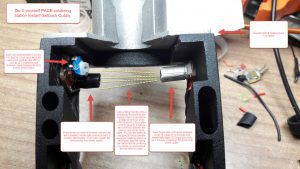Issue
Some of the work I do, such as soldering components with large thermal mass on multi-layer boards, requires the use of a high-powered, temperature controlled soldering station with fast thermal recovery and lead-free soldering capability. An under-powered 35W soldering station I already own, just isn’t suitable for that type of work. So, I treated myself with a PACE ST-50 80W Digital Soldering Station which came with a composite / cartridge type soldering iron and a standard tool stand. Since the heater element and thermal sensor have been integrated into the soldering iron tip, the thermal transfer is excellent and overshoot is eliminated. The build quality of this station is exceptional.
PACE also offers a smart tool stand that is capable of detecting the presence of the soldering iron. It is called an ISB or Instant-SetBack Cubby (Part #: 6019-0084-P1) and it costs around 100 USD. When the ISB Cubby detects the presence of the TD-100 soldering iron, it waits for 45 seconds and then puts the iron into the temperature Setback mode. Setback Mode means that the temperature is reduced to just below solder melt temperature (176°C/350°F) so the corrosive action of the leaded or Lead-Free solder is stopped, maximizing the life of the tip and minimizing the electricity bill. When the iron is removed from the cubby, the system returns to normal operation within seconds. The mentioned cubby is suitable for ST 30, ST 50, ST 65, ST 70, ST 75, ST 115, WJS 100, MBT 301 & MBT 350 units.
Since ISB Cubby Mini-DIN-3 port has been present on the back side of my unit, I did some research on the soldering iron detection mechanism. I came up with a simple, but reliable do-it-yourself, minimal component and low cost solution. All the information required was provided in this thread on the eevblog.com. I was reluctant to use a simple mechanical switch due to the reliability issues; the iron handle is too light to surely activate the switch every time, moreover switch shorting or burn could occur in the harsh, high-temperature and solder spatter contaminated environment. I couldn’t use an infrared activated switch solution since I didn’t have an IR photo-transistor or an IR LED on hand. However, I could easily find an ordinary white LED diode, a photoresistor (or light-dependent resistor, LDR, or photocell; light-controlled variable resistor), NPN transistor (or bipolar junction transistor, BJT for short), 500K potentiometer (or pot, variable resistor, rheostat) and a Mini-DIN-3 connector cable (a modified Mini-DIN-4, Mini-DIN-7 or S Video Cable can also be used). These are all the parts that are needed for this simple light-activated switch / soldering iron detection circuit.

Read More